Solar Radiation at Different Hours, Discrete Ordinates (DO) Radiation Model
$120.00 $60.00 Student Discount
- The problem numerically simulates solar radiation at different hours using ANSYS Fluent software.
- We design the 3-D model by the Design Modeler software.
- We Mesh the model by ANSYS Meshing software, and the element number equals 2054294.
- This study is performed based on the geographical characteristics of Baku (The capital of Azerbaijan) at 8 AM and 3 PM on June 21st.
- We perform this simulation as unsteady (Transient).
- We use Discrete Ordinate Radiation (DO) and Solar Ray Tracing to consider radiation heat transfer.
To Order Your Project or benefit from a CFD consultation, contact our experts via email (info@mr-cfd.com), online support tab, or WhatsApp at +44 7443 197273.
There are some Free Products to check our service quality.
If you want the training video in another language instead of English, ask it via info@mr-cfd.com after you buy the product.
Description
Solar Radiation at Different Hours CFD Simulation by ANSYS Fluent Solar Ray Tracing Model Training
This simulation is about Solar Radiation at Different Hours via ANSYS Fluent software. We perform this CFD project and investigate it by CFD analysis.
Due to the curvature of the earth’s axis around the sun, it receives different intensities and angles of radiation in different seasons of the year. Therefore, more radiation was received in the tropical regions due to the intensity and angle of radiation close to zero.
On the other hand, latitude, longitude, and distance from Greenwich origin indicate a unique place on earth to represent a city. Simultaneous modeling of conduction, convection, and solar radiation can predict surfaces exposed to heat transfer and find critical temperature points.
In this study, the effects of radiation from the sun in an environment where airflow is established are investigated. In addition, the conduction heat transfer was considered in solid objects.
The amount of radiation received was modeled with the geographical characteristics of Baku (The capital of Azerbaijan) at 8 AM and 3 PM on June 21st. The free air velocity was 10 m / s with a temperature of 27 degrees Celsius.
Soil, brick, and wood material specifications were given for land, house, and tree. Finally, by examining the radiation flux, objects’ surface temperature, and the average temperature inside the house, radiation heat in the morning and noon was determined.
The geometry of the present model is drawn by Design Modeler software. The model is then meshed by ANSYS Meshing software. The model mesh is unstructured, and 2054294 cells have been created.
CFD Method
In this simulation, the radiation model is used to define the radiation heat transfer; Because the main heat transfer method for thermal analysis in this project is the radiation method. Therefore, the discrete ordinate (DO) model is used to define radiation.
The discrete ordinates model is used for cases where the radiation heat transfer equations are solved for a finite number of discrete solid angles. This model is the most comprehensive radiation model.
It is used for scattering light, semi-transparent environments, glossy surfaces such as mirrors, and wavelength-dependent transitions.
Also, Solar-Ray tracing has been used to define the solar radiation in the computational zone of the model. In this problem, longitude and latitude, time zone, and day and hour radiation are determined. Based on these data, the intensity of solar radiation and the direction of solar radiation is obtained.
Solar Radiation at Different Hours Conclusion
After simulation, the contours of temperature and radiation heat flux are obtained. Also, the maximum temperature in the computational zone is obtained for two study cases (8 and 15 o’clock).
It was observed that according to the amount of radiation received by the domain at different hours, as gets closer to 15 o’clock with increasing radiation intensity and angle compared to 8 o’clock, a difference of 6 degrees was obtained from the maximum temperature.
The maximum temperature was about 312 K at 8 AM and 318 K at 3 PM. Due to the thermally safe zones in terms of temperature between the houses and the shade of the tree, the amount of radiation flux received in these areas for two different cases was in the range of 50 to 70 W / m2, which indicates that with increasing heat received from the sun, in shady areas will not be felt much.
This CFD Project is the 6th episode of the Radiation Model Training Course.



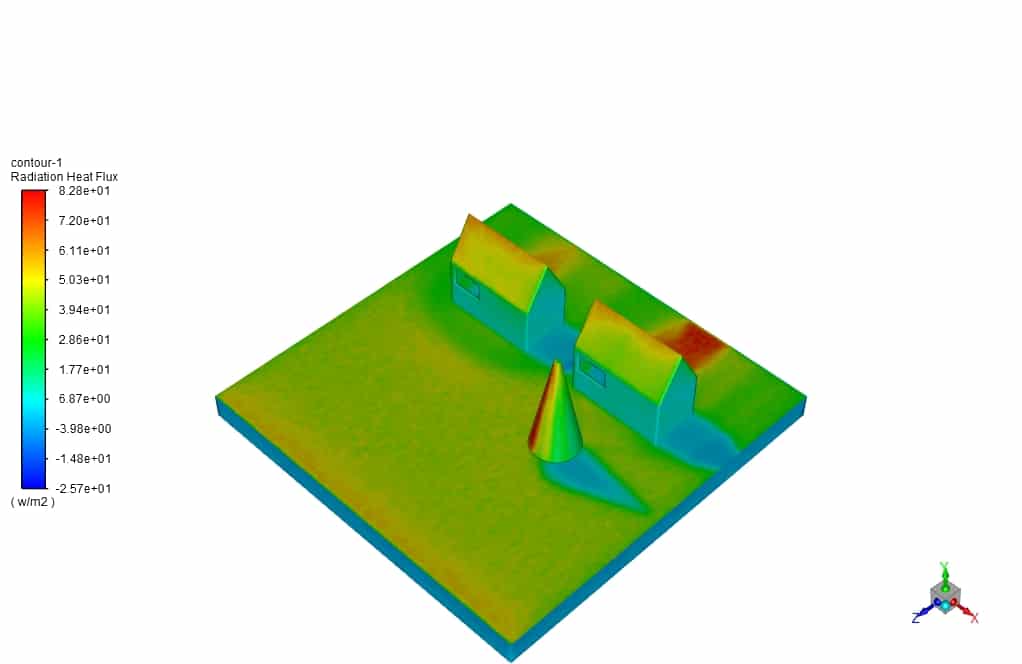
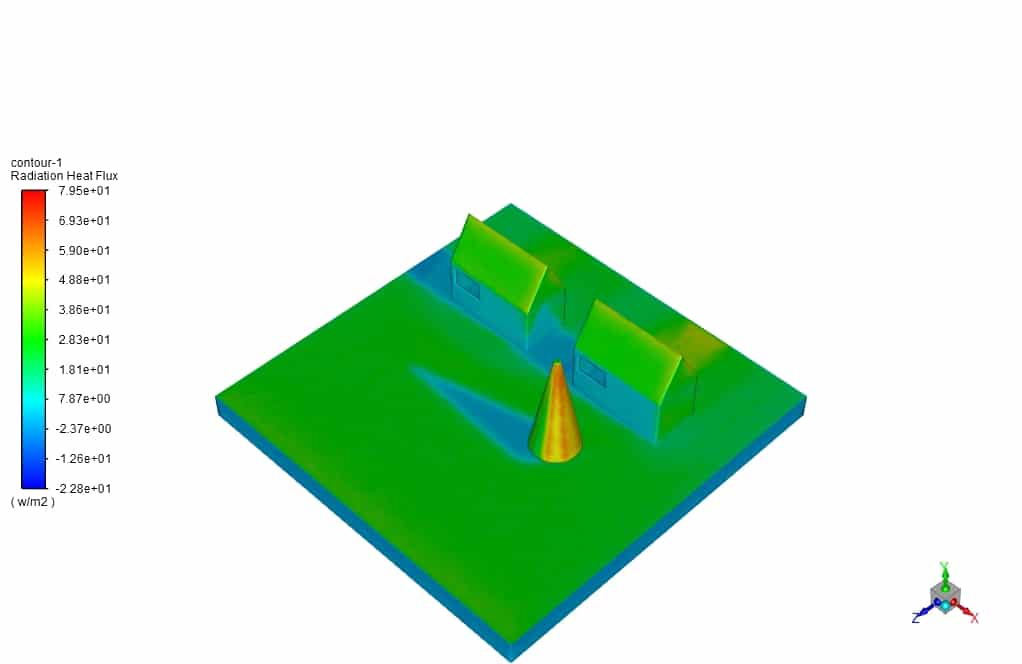
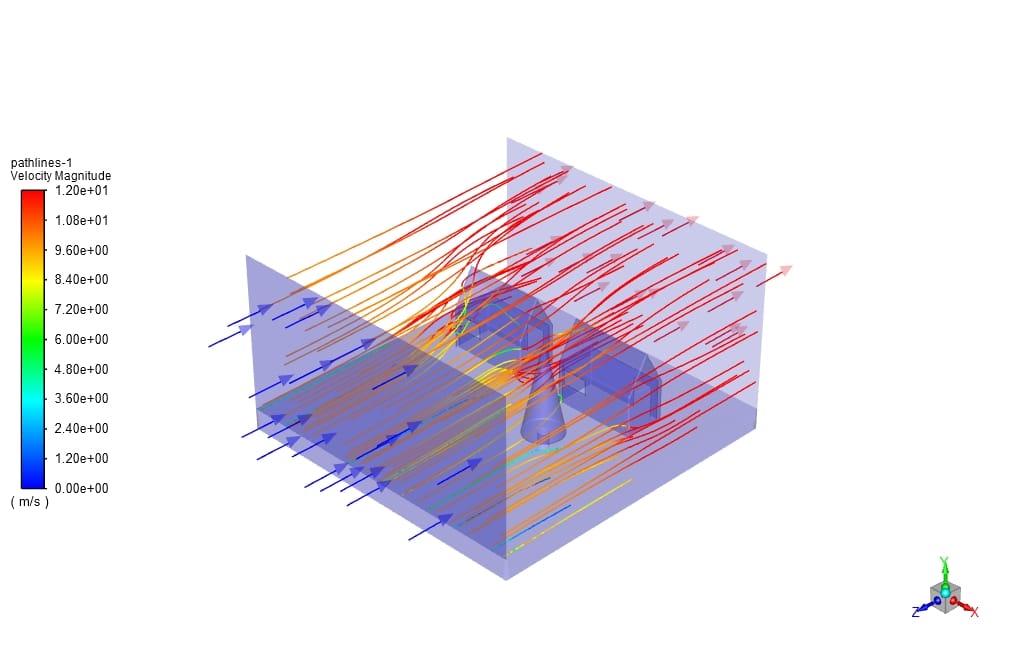
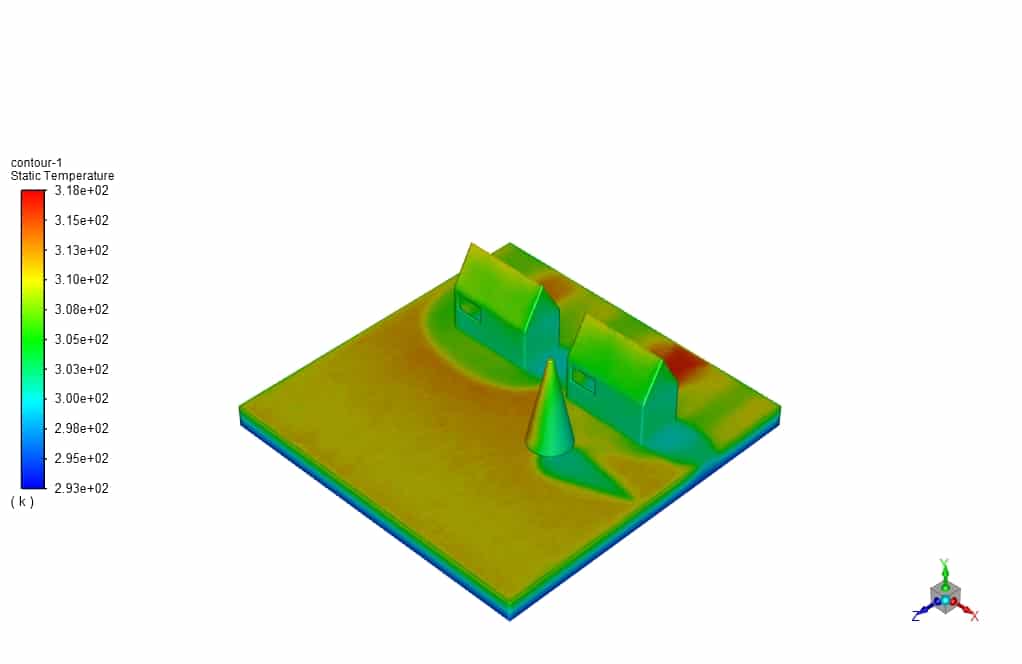
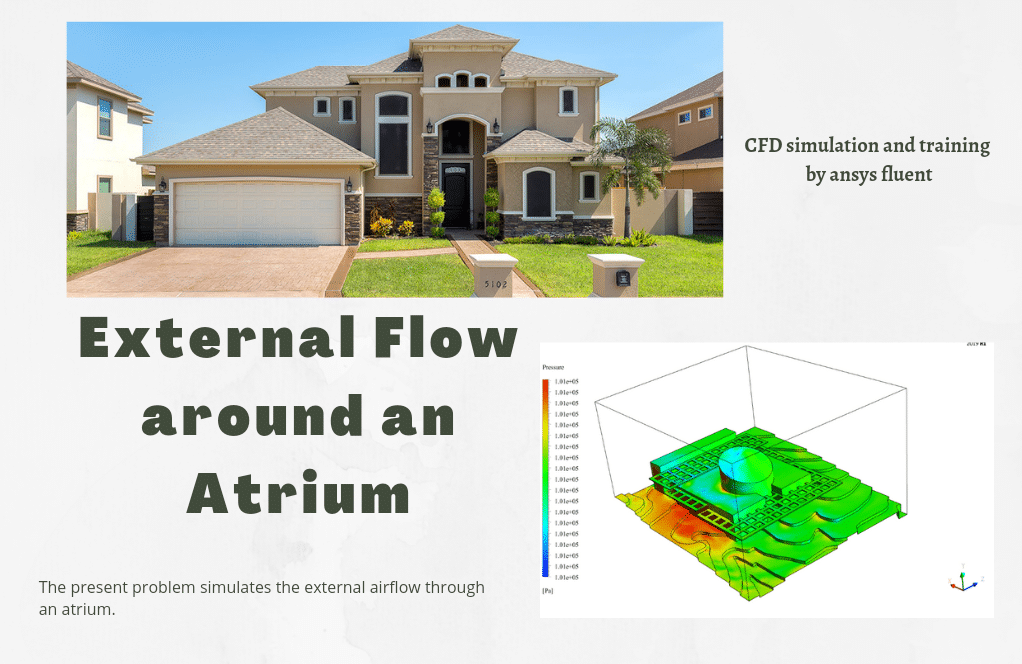

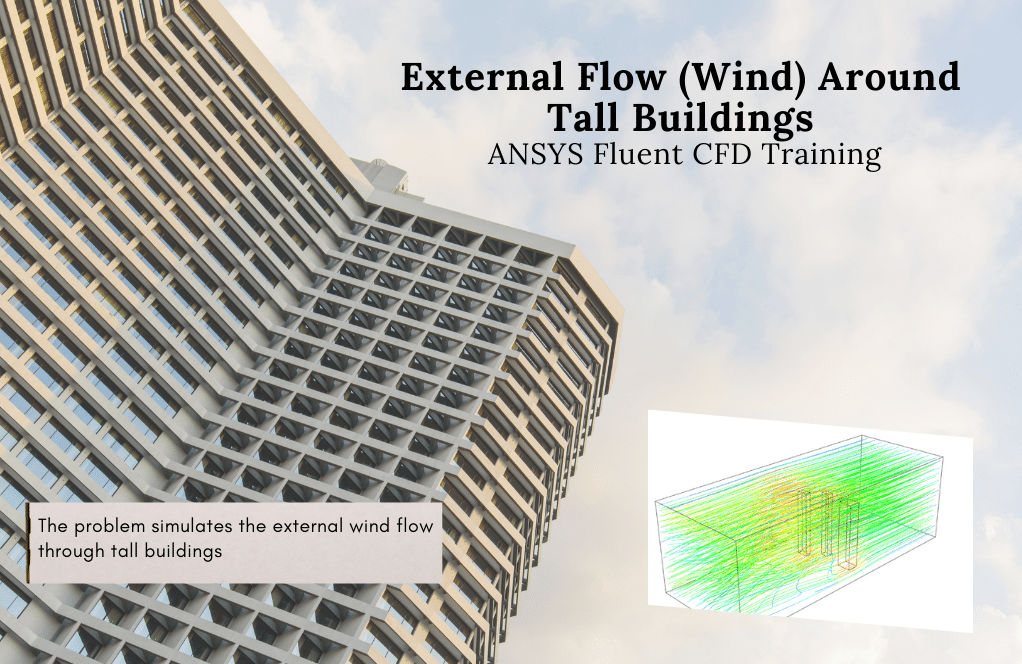
Loraine Treutel –
What factors are considered to model solar radiation accurately for a specific location and time in the simulation?
MR CFD Support –
To accurately model solar radiation for a specific location and time in a simulation, the factors considered include the geographical latitude and longitude of the location, the local time zone, the date and time of day, and the intensity and incident angle of the solar radiation specific to that date and time. Additionally, material properties such as reflectivity and heat capacity, along with environmental conditions like air temperature and velocity, are also taken into account.
Cornelius Graham –
I enjoyed learning how solar radiation varies at different times of day using the ANSYS Fluent software. The inclusion of environmental factors and materials like soil, brick, and wood made the simulation very comprehensive. Are there any additional environmental factors, such as cloud cover or pollution, that were accounted for in this simulation?
MR CFD Support –
Thank you for your feedback! In this specific simulation, the focus was primarily on direct solar radiation, the geography of Baku, and the time of day’s impact on radiation intensity and angle. Cloud cover and pollution were not directly accounted for in this simulation, as it focused on clear conditions to assess the maximum solar radiation impact on temperature and radiation heat flux on surfaces. If required, these environmental factors can be included in a more detailed model to capture their effect on solar radiation.
Shawn Bradtke –
I was wondering why the radiation flux range is only 50 to 70 W/m2 in the shaded areas. Could you elaborate on that?
MR CFD Support –
The radiation flux range of 50 to 70 W/m2 in the shaded areas is due to the shadowing effect provided by the buildings and trees in the simulation. These structures block direct solar radiation, resulting in a significant decrease in heat transfer by radiation to those areas. This demonstrates how shade can effectively keep temperatures lower during peak solar radiation hours.
Cristian Roberts –
Is the soil, brick, and wood material properties considered constant when radiation absorption and heat transfer are being calculated?
MR CFD Support –
In this simulation, material properties like the thermal conductivity and specific heat of soil, brick, and wood are generally assumed to be constant. However, elaborate simulations may use temperature-dependent properties to increase accuracy when analyzing radiation absorption and heat transfer effects on these materials.
Della Hirthe –
I found the comparative analysis of radiation heat flux at different hours very insightful. However, I am curious to know whether cloud cover impacts were considered in your simulation for solar radiation calculations, and if so, how?
MR CFD Support –
In this particular simulation focusing on Solar Radiation at Different Hours using the Discrete Ordinates (DO) model, cloud cover impacts were not explicitly mentioned in the description provided. Usually, the effect of cloud cover can be incorporated into simulations by adjusting the solar radiation intensity to reflect the attenuation caused by clouds. If needed, such factors can be integrated into the model using ANSYS Fluent’s capabilities to ensure a more realistic environmental representation in CFD analysis.
Cathrine Eichmann –
I’m quite impressed by the thoroughness of the CFD analysis for solar radiation at different hours! Out of curiosity, was any particular method used to validate the accuracy of the simulation results, like comparing with empirical data or a reference case study?
MR CFD Support –
Thank you for the compliments on our product. We always aim for precision in our simulations. Regarding the validation process, yes, we typically validate our simulations through comparison with empirical data or established case studies when available. This ensures that our models predict the physical phenomena with high fidelity.
Kayli Hackett –
I’ve noticed the DO radiation model was utilized for this simulation. Could you help me understand why the DO model is particularly chosen for simulating solar radiation over other radiation models?
MR CFD Support –
The Discrete Ordinates (DO) model is ideal for simulating solar radiation due to its ability to handle complicated geometries, reflection, refraction and absorption within participating media. It offers detailed directional radiation intensity and can specifically account for wavelength-dependent phenomena, which is essential for accurate solar radiation simulation.
Atul –
Very Nice case study for Solar ray tracing method. I have a 2 questions. Does solid bodies (Brick, soil, etc) are considered as fluid? and what settings kept for Radiation tab of Wall boundary conditions?
Reza Amini –
no, all solid has been modeled as solid cell zone condition with small thickness,
Hertha Prosacco –
How does the surface roughness of the materials affect the results of the radiation model? For example, does the simulation consider the differences between rough wood and smooth brick surfaces when determining the temperature and radiation heat flux contours?
MR CFD Support –
In the context of the described simulation, the roughness of the surfaces can have an impact on how they absorb and reflect solar radiation. Rough surfaces can scatter radiation more than smooth surfaces and can potentially absorb more radiation due to a larger surface area. However, surface roughness is characteristically a sub-grid phenomenon that may not be directly accounted for at the cell level, especially in larger-scale simulations such as this one. Instead, it may be incorporated into the material properties and boundary conditions rather than explicitly modeled. If you are specifically interested in surface roughness effects, material properties like absorptivity, reflectivity, and emissivity can be adjusted to reflect the influence of roughness on thermal radiation calculations.
Prof. Ernestine Ratke PhD –
Does the simulation take into account the reflective properties of different materials when calculating the solar radiation impact at various hours?
MR CFD Support –
Yes, the simulation includes the reflective properties of different materials by using the discrete ordinates (DO) radiation model, which is suitable for predicting the impact of radiation on glossy or reflective surfaces. It also accurately accounts for radiation heat transfer, which is essential for assessing the impact of solar radiation at different times.
Milan Crist –
The simulation details were great! It was fascinating to see how solar radiation changes the temperature throughout the day. I was particularly impressed by the use of the DO radiation model for different times of the day and the temperature differences observed.
MR CFD Support –
Thank you for your kind words! We’re delighted to hear that you found the simulation details fascinating and that the DO radiation model provided clear and insightful results. It’s wonderful to know that the temperature observation was impressive. We look forward to providing you with more valuable simulations in the future.
Ora Hermann –
I was wondering if the DO radiation model accounted for surface reflections in this simulation, given that it mentions glossy surfaces like mirrors.
MR CFD Support –
Yes, the DO (Discrete Ordinates) radiation model in this simulation does account for surface reflections. This model considers the radiation heat transfer equations for a finite number of discrete solid angles and is suitable for cases involving shiny or reflective surfaces, which include specular reflection of radiative heat.
Dr. Dylan Breitenberg I –
In the simulation that evaluates solar radiation at different hours, how is the Solar-Ray tracing model specifically set up to account for the change in solar intensity and angle during the day?
MR CFD Support –
The Solar-Ray tracing model in the simulation is customized by the software to account for the variation in solar intensity and angle based on the geolocation, which is represented by longitude and latitude settings, as well as the specified time of day and date. These configurations enable the model to accurately simulate the trajectory and intensity of solar radiation for the provided location (Baku) and the times of day being evaluated (8 AM and 3 PM on June 21st).
Daren Schmitt DVM –
The provided explanation was quite informative. Kudos to the MR CFD team for such a meticulous and detailed simulation study on the impact of solar radiation during different times of the day.
MR CFD Support –
We truly appreciate your positive feedback on the Solar Radiation at Different Hours CFD Simulation training module. It’s our pleasure to deliver detailed and comprehensive analyses to aid in understanding complex phenomena. Thank you for choosing MR CFD for your learning journey!
Lurline Koch –
The analysis mentions using the Solar-Ray tracing model. Can you explain how this model contributes to the accuracy of the simulation results?
MR CFD Support –
The Solar-Ray tracing model significantly improves the accuracy of the simulation by accounting for the position of the sun and its angle of incidence at different times and locations. It calculates the intensity and direction of solar radiation, taking into consideration the geographical coordinates, time zone, date, and hour. This ensures more accurate modeling of the solar radiation’s effects on the environment and objects within it at various times of the day.
Jillian Eichmann –
I thoroughly enjoyed learning about solar radiation’s impact at various times of the day through the Discrete Ordinates Radiation Model. The case studies of Baku’s different hours were informative and engaging. With precise meshing and detailed simulation results, it’s clear how solar intensity and angle can significantly affect temperature distribution. It’s fascinating to see the real-world application of CFD analysis in environmental studies, and this course did an excellent job illustrating it. Well done on incorporating the effects of conduction, convection, and radiation so cohesively!
MR CFD Support –
Thank you for your positive review. It’s great to hear that our Solar Radiation at Different Hours CFD simulation was beneficial for your learning and that you found the incorporation of the various heat transfer effects to be seamless. We strive to deliver detailed and real-world applicable content to our learners, and it’s rewarding to know that we have met your expectations. If you have any questions or need further information on simulations like this, feel free to reach out. We appreciate your feedback and hope you continue to find our learning products enlightening!
Ms. Reta Lindgren I –
The versatility of the Discrete Ordinates model is impressive, especially how it adapts to various environmental conditions. I appreciate the detailed inclusion of longitude, latitude, and even time zone specifics for Baku, plus the use of time-stamped solar radiation intensity. The temperature differences between the hours and the physiological inference of ‘thermally safe zones’ are especially insightful. Excellent work on demonstrating practical applications of solar radiation simulation!
MR CFD Support –
Thank you so much for your kind words! It’s truly rewarding for us to know that the detailed approach we adopted in dealing with environmental conditions, geographic specifics, and temporal characteristics, has proven helpful and insightful. We’re glad the simulation results, like the temperature differences and ‘thermally safe zones’, have aided you in recognizing the range of applications for solar radiation studies. We deeply value your feedback and look forward to offering you more valuable learning experiences with our CFD projects.
Prof. Sharon Ortiz DVM –
I was amazed at the detail of the temperature and radiation heat flux contours in this simulation. It really helps to understand the impact of solar radiation at different times of the day, and the way shading can drastically influence the local temperature.
MR CFD Support –
Thank you so much for your positive feedback! We are glad that the simulation’s results on temperature and radiation heat flux contours were detailed and helpful in your understanding of solar radiation’s impact. It’s wonderful to hear that it has provided insight into shading effects and local temperature variations. Your appreciation means a lot to us!
Jaquan Howe –
The detailed simulation report mentions that more radiation is received in the tropical regions due to the intensity and angle of radiation close to zero. How does this simulation take into account the geographical location-specific radiation characteristics of Baku at different times?
MR CFD Support –
In this simulation, the specific geographical location of Baku is taken into account by setting the correct latitude, longitude, and time zone within the Solar-Ray tracing model parameters. The model also includes the precise date and hours (8 AM and 3 PM) to accurately depict the intensity and direction of solar radiation based on Baku’s location on June 21st. This ensures that the simulation accurately represents the solar radiation that Baku would receive at these specific times, giving reliable data on temperature gradients and radiation heat flux in different areas of the computational domain.
Calista Hintz V –
Are the materials for the land, house, and tree customizable? Can we simulate using different materials for these objects?
MR CFD Support –
In the simulation, material specifications such as thermal conductivity and specific heat are defined for the different objects. These properties can be customized, which allows for the simulation of various materials. Just make sure that the adjusted material properties correctly reflect the thermal behaviors you want to investigate in the target materials.
Carley Strosin DVM –
Is it possible to apply this type of simulation to other geographic locations, and how would we need to adjust the settings in ANSYS Fluent for accurate results?
MR CFD Support –
Yes, you can apply this simulation to other geographic locations. You would need to adjust the latitude and longitude settings to match your desired location. Additionally, you should input the correct time zone, date, and time to simulate the accurate position of the sun. In ANSYS Fluent, make sure that the Solar-Ray tracing parameters reflect these geographical and temporal details so that the intensity and angle of the incoming solar radiation are modeled correctly.
Emilia Ebert –
The simulation outcome presented consequences of varying solar angles throughout the day on temperature. Can MR CFD explain how the DO radiation model captures the effects of reflective surfaces in the simulation environment?
MR CFD Support –
In the ANSYS Fluent DO (Discrete Ordinates) radiation model, the effects of reflective surfaces in the simulation environment are captured by tracking a finite number of rays as they reflect off surfaces within the domain. The DO model takes into account the surface properties, including reflectivity and emissivity, which determine how much radiation is absorbed, reflected, or emitted by the surfaces. Reflective properties can be set specifically for different materials within the computational mesh, allowing the model to simulate how solar radiation interacts with these materials, including glossy or mirror-like surfaces. This detailed consideration of reflectivity helps in accurately estimating temperature changes and radiation heat flux in the simulation.
Dr. Constantin Keeling II –
I love how the simulation accounts for the real-world parameters of Baku’s geographical characteristics. It’s really impressive seeing the differences in radiation and temperature changes throughout the day. The discrete ordinates model seems ideal for analyzing such complex interactions between radiation and materials.
MR CFD Support –
Thank you for your kind words! We’re glad to hear that you appreciated the detailed approach we took in incorporating real-world geographical data into our simulation. It’s our goal to provide comprehensive and realistic analyses that can be useful for understanding environmental and material interactions with solar radiation. Your feedback is very encouraging for our team!
Armand Rutherford II –
What are the primary materials used in this simulation and their respective thermal properties?
MR CFD Support –
In this simulation, soil, brick, and wood materials are used to represent the land, house, and tree, respectively. Their thermal properties such as thermal conductivity, density, and specific heat would be defined based on standard values for these materials appropriate for CFD analysis.
Hillary Nikolaus II –
Can you please explain the advantage of using the discrete ordinates (DO) model for this kind of simulation?
MR CFD Support –
The advantages of using the discrete ordinate (DO) radiation model for simulations like solar radiation are numerous. The DO model can accurately account for complex phenomena like scattering, semi-transparency, and reflections from glossy surfaces. It’s capable of solving radiation heat transfer equations for a variety of discrete angles, providing a comprehensive analysis that is ideal for simulating the effects of solar radiation considering directional intensity and wavelength dependencies.
Laila Wilderman –
The tutorial mentioned considering soil, brick, and wood for various elements in the geometry. Could you explain how the material properties for these constructions impact the radiation and thermal analysis results?
MR CFD Support –
In the simulation, the melanotic properties of construction materials like soil, brick, and wood have significant impact on the level of heat absorption and rate at which heat is conveyed through these materials. Soil generally has different thermal conductivity than brick and wood, affecting heat conduction rates within the substances and consequently the overall thermal analysis in a given environment. This intricate interplay of material properties helps to predict temperature distribution and the amount of thermal energy each of these objects retains or repels under solar radiation.
Enid Keebler –
I was impressed with the level of detail in this simulation offering insights on solar radiation at different times. Great job showing the temperature differences and the effect of shading!
MR CFD Support –
Thank you for your kind words! We’re thrilled to hear you found the simulation detailed and insightful. It’s wonderful to know the temperature difference and shading effects were clear. If you have any further questions or need more clarifications on other simulations, please feel free to ask. We appreciate your feedback!
Jeramie Dooley –
The simulation for Solar Radiation at Different Hours sounds intriguing! Could you please elaborate on how the DO radiation model and solar ray tracing feature worked together to accurately simulate solar radiation for different times of the day?
MR CFD Support –
The DO radiation model was integrated with the solar ray tracing feature to calculate radiation heat transfer considering the solar position and intensity based on geographic data. For each specific timeframe (like 8 AM and 3 PM), solar ray tracing applied the calculated solar radiation intensity and direction. Together, these models determine how solar energy distributes across various surfaces in the computational domain, accounting for factors like reflection, absorption, and shadowing. This offers an accurate representation of the effects of solar radiation on the environmental temperature at different hours.
Alexa Friesen –
I was very impressed with the level of detail in the simulation, especially the use of Solar-Ray tracing to define the effect of solar radiation on different surfaces and times of the day. The analysis of temperature variations and radiation flux at different hours is incredibly valuable for understanding thermal effects in real-world applications. Great job on accurately representing the geographical specifics of Baku in the model!
MR CFD Support –
Thank you for your positive feedback! We are glad that the detailed Solar-Ray tracing and analysis of solar radiation could meet your expectations and provide valuable insights. It’s our goal to create accurate and useful simulations that can be applied to real-world conditions. If you have any more questions or need further assistance, please do not hesitate to reach out.
Ms. Madalyn Leffler –
What were the similarities and differences in the radiation flux received at 8 AM and 3 PM, and how is the shadow effect considered in the simulation?
MR CFD Support –
In the simulation, you’ll notice that the radiation flux received at 8 AM and 3 PM differs due to the change in the sun’s position, which affects both the intensity and the angle of the radiation. As it gets closer to 3 PM, the intensity of solar radiation increases, and with that, the maximum temperature also rises. Regarding the shadow effect, the simulation uses the Solar-Ray tracing model to accurately predict the propagation of solar rays and their interaction with the environment, including shadowed areas. This results in varying radiation fluxes in shaded regions, showing lower values that signify the cooling effect of shadows.
Aurelio McClure –
Really impressed with the attention to detail in simulating different solar radiation intensities based on geographical characteristics and time adjustment! It’s great to see how convection, conduction, and radiation were all included. This really paints a complete picture of heat transfer processes in a real-world setting.
MR CFD Support –
Thank you for taking the time to review our Solar Radiation at Different Hours CFD Simulation training course. We’re thrilled to hear that you appreciate our comprehensive approach to simulating the nuances of solar radiation and its impact. It’s our goal to provide insightful and realistic simulations, so users like you can have a practical understanding of how various heat transfer methods interact with the environment. Thanks again for your positive feedback!
Blaze Romaguera –
I was impresssed by the findings of the Solar Radiation study at different hours. Owing to the simulation examples provided, I now have a clearer understanding of how solar incidence and radiation flux can substantially vary throughout the day! It’s amazing to see the tangible impacts such as a 6 degrees temperature difference between morning and afternoon hours. Also, the revelation about thermally safe zones under tree shades puts a practical spin on urban planning strategies. Fabulous work!
MR CFD Support –
We truly appreciate your thoughtful and positive review! It’s rewarding to hear that the analysis and presentation of the simulation data have provided valuable insights. Your acknowledgment of the urban planning implications shows the depth of your understanding of its applications. We thank you for taking the time to provide such a comprehensive compliment and are pleased to know our product helped in enhancing your understanding of solar radiation’s dynamic nature. Keep learning and exploring with us!
Scotty Waters –
Fantastic learning tool! The solar radiation CFD simulation project clarified so many concepts for me. I particularly appreciated the detail on the discrete ordinate model and how sunlight intensity varies at different times. It demonstrated practical application, and the datasets for Baku were very engaging. Great course for anyone interested in environmental CFD studies!
MR CFD Support –
Thank you so much for your positive feedback! We are thrilled to hear that our Solar Radiation at Different Hours simulation course was helpful and engaging. Understanding the discrete ordinates radiation model and its practical applications is crucial for accurate environmental CFD analysis, and we’re glad you found the dataset and case studies for Baku informative. Your compliment is highly appreciated, and we look forward to providing more valuable learning experiences.
Porter Stamm –
Loved the detailed explanation in your Solar Radiation at Different Hours CFD Simulation training. It’s impressive how you accommodate the geographical peculiarities of a location like Baku to assess the variance in solar heat transfer. The integration of radiation heat flux insights provides great value in understanding temporal environmental changes. Cheers to MR CFD for a comprehensive and astutely curated learning module!
MR CFD Support –
Thank you for your kind words! We’re thrilled that you appreciated the comprehensiveness and attention to detail in our Solar Radiation at Different Hours simulation training. It’s great to hear that the course was valuable in deepening your understanding of solar heat transfer. We continuously strive to create informative and accurate educational materials and your feedback is highly motivating. Don’t hesitate to reach out if you have any more questions or need further training materials.
Dr. Ezra Kassulke Jr. –
The CFD analysis of solar radiation at different times is fascinating. The implementation of various materials and the impact of the tree’s shade are insightful contributions to the simulation. It was especially interesting to see the recorded temperature difference at 8 AM and 3 PM which confirms the influence of thermal effects throughout the day.
MR CFD Support –
Thank you for your positive feedback on the Solar Radiation at Different Hours CFD Simulation and for noting the details of the various material impacts and environmental factors like the shade of a tree. We’re glad to hear that the simulation provided meaningful insights into thermal effects and helped portray how solar radiation intensity influences temperature variances during different times of the day.
Prof. Katharina Hermann MD –
This CFD project on solar radiation sounds really comprehensive. Could you provide me with more details regarding the specific parameters that were set for solar ray tracing and how these might affect the results?
MR CFD Support –
Regarding the specific parameters set for solar ray tracing in this CFD project, aspects such as geographic location (latitude and longitude of Baku), time zone adjustments, as well as the time of day (8 AM and 3 PM) and the date (June 21st) profoundly impact the simulations. These parameters influence the angle and intensity of the solar radiation received, which in turn, affects the resulting temperature distribution and radiation heat flux within the environment. Additionally, due to the comprehensive nature of the discrete ordinate (DO) model used for radiation, factors like scattering light, surface properties, and wavelength-dependent transitions are also considered, leading to a nuanced and accurate representation of solar radiation’s effects at different hours.
Mona Kilback –
I’m curious how the Solar-Ray Tracing model considers the geographical characteristics of a particular location like Baku in the simulation. Does it account for things like altitude or just latitude and longitude?
MR CFD Support –
The Solar-Ray Tracing model in this simulation takes into account several geographical characteristics, including not just the latitude and longitude but also specifics such as the date and time when calculating the direction and intensity of solar radiation. It uses this data to closely approximate the angle of incidence and intensity of sunlight that a particular location on Earth would receive. Altitude can also be a factor in solar radiation simulations for accounting changes in air density and other properties, but in this case, it’s not mentioned whether altitude was specifically included for Baku.